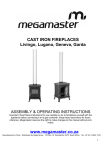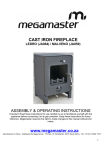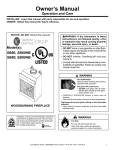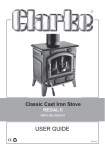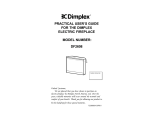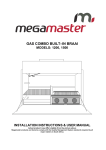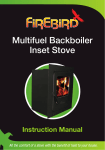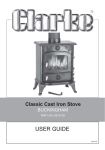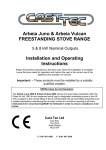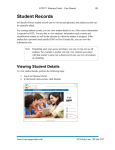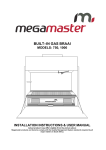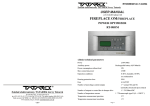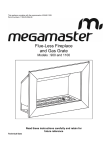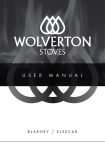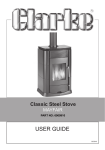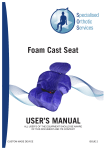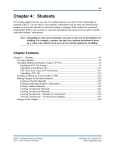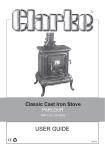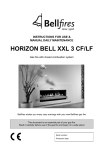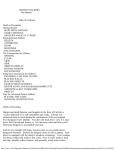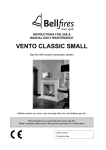Download mm ambiante 700 fireplace
Transcript
CLOSED COMBUSTION FIREPLACE AMBIANTE 700 ASSEMBLY & OPERATING INSTRUCTIONS Important: Read these instructions for use carefully so as to familiarize yourself with the appliance before connecting it to its gas container. Keep these instructions for future reference. Megamaster reserves the right to make changes to this manual without prior notice. www.megamaster.co.za Manufactured in China · Distributed by Mega Group · PO Box 15, Woodlands, 0072, South Africa · Tel: +27 (0) 12 802 1515 1 INTRODUCTION Thank you for purchasing this Megamaster Closed Combustion Fireplace. Before attempting to install or use the fireplace, please read this manual throughout and follow the instructions carefully. Thoroughly familiarize yourself with this fireplace & it’s operation in order to ensure the safety of yourself and others around you. Henceforth, you can look forward to the fireplace giving you long and satisfactory service. This fireplace is designed to operate with “hardwood fuel”; no other fuels should be used in this fireplace. GUARANTEE Megamaster Closed Combustion Fireplaces are guaranteed for a period of 5 years from original date of purchase. The guarantee will cover all manufacturing and material defaults. Removable and replaceable working components will be covered for a 12-month period from the original date of purchase. A copy of the proof of purchase must be kept to validate any claims. The conditions of this warranty are subject to the correct assembly, installation, safe-operating, cleaning and maintenance conditions as prescribed within this user manual. Failure to comply with the instructions of this user manual will render the guarantee null and void. The following is not covered by this guarantee: 1. Glass Panel 2. Rope and gasket seals 3. Paint discoloration (irrespective of the period after purchase) 4. Rust and rust related problems (irrespective of the period after purchase) 5. Fire Bricks Megamaster reserves the right to either repair or replace any fireplaces or components at their discretion. Megamaster will not be held accountable for any loss or damaged of any kind suffered due to the incorrect installation or operating of this fireplace. Costs associated with the replacement or repair will be covered by the guarantee for the first 12 month. This guarantee is not transferable and applies to all residents within South Africa, Botswana and Namibia. Other countries will be considered on discretion of Megamaster. For any general quires regarding the conditions of this guarantee, please contact Megamaster. Please note that details and specifications contained herein are correct at the time of going to print. All data is applicable to wood burning use only. Megamaster reserves the right to change specifications at any time without prior notice. PRODUCT SPECIFICATION Product Overall Sizes (mm) Weight (kg) Heat Output (kW) Flue Outlet Glass Size (mm) Flue Size (mm) Ambiante 700 (W) 706 * (D) 476 * (H) 800 104 8,8 Top 388 x 256 150 2 INSTALLATION OF THIS PRODUCT WARNING! AN ACCREDITED FIREPLACE INSTALLER SHOULD CARRY OUT THE INSTALLATION OF THIS FIREPLACE. ALTERNATIVELY, SHOULD A NONACCREDITED INSTALLER UNDERTAKE THE INSTALLATION, YOUR LOCAL BUILDING CONTROL OFFICER WILL BE REQUIRED TO APPROVE THE COMPLETED INSTALLATION. IF THE FIREPLACE IS NOT FITTED CORRECTLY, BY AN ACCREDITED PERSON OR OUTSIDE THE SCOPE OF THIS MANUAL IT COULD RESULT IN A HOUSE FIRE OR CARBON MONOXIDE POISONING. READ ALL THE INSTRUCTIONS CAREFULLY BEFORE INSTALLATION The instructions cover the basic principles to ensure satisfactory installation of the fireplace, although details may need a slight modification to suit particular site conditions. In all cases the installation must comply with current Local Authority Byelaws. This guidance information in no way replaces your responsibility as an installer or end user to comply with the appropriate standards. SAFETY WARNINGS FOR YOUR GUIDANCE THIS FIREPLACE WILL BE HOT when in operation and due care should be taken. Thick gloves should be used to operate the primary/ secondary controls or reaching inside the fireplace to position fuel or remove ash. FIRES CAN BE DANGEROUS - Always use a fireguard in the presence of children, the elderly or the infirm. DO NOT OVERFIRE - it is possible to fire the fireplace beyond its design capacity. This could damage the fireplace, so watch for signs of over firing - if any part of the fireplace starts to glow red, the fireplace is in an over fire situation and the controls should be adjusted accordingly. Never leave the fireplace unattended for long periods without first adjusting the controls to a safe setting. Careful air supply control should be exercised at all times. THIS FIREPLACE MUST BE CONNECTED TO A SUITABLE FLUE OUTLET. Due to high temperatures this fireplace should be located well away from furniture and curtains. Children and adults should be alerted to the hazards of hot surfaces. Young children should be carefully supervised when they are in the same room as the fireplace. Do not place clothing or other flammable material on or near the fireplace. Keep the fireplace area clear of combustible materials, flammable liquids or vapors. CARBON MONOXIDE POISONING CAN BE FATAL. Due consideration should be given to the dangers of carbon monoxide poisoning following incomplete combustion of solid fuels in an enclosed space. See page 14 in this booklet. Ensure the room were this product is installed is well-ventilated, additional air bricks may need to installed to allow for a source of permanent ventilation. 3 GENERAL SAFETY RULES 1. ALWAYS read and understand the manual before installing and commissioning the fireplace. 2. ALWAYS ensure the fireplace is installed in accordance with local regulations. 3. ALWAYS ensure that the fireplace is correctly installed and positioned as described in the diagram on page 7, and that the immediate area is kept clear. 4. ALWAYS check for damage before using the fireplace. Check for breakage of parts and any other condition that may affect the fireplaces performance. Any damage should be properly repaired or the part replaced. If in doubt, DO NOT use the fireplace. Consult your local dealer. 5. ALWAYS keep children and visitors at a safe distance from the fireplace. 6. NEVER direct any kind of liquid on to the fireplace, particularly when it is hot. 7. NEVER use gasoline or other flammable liquids for fire starting. 8. NEVER use the fireplace to incinerate materials other than recommended fuels. 9. NEVER carry out any modifications to this product. If experiencing difficulty of any kind consult your local dealer. 10. The installation of the fireplace and chimney MUST comply with all local building regulations. It is the responsibility of the owner and the installer to ensure that the installation complies. 11. All rooms where a fireplace is situated must have a non-motorized air vent (air brick). Refer to details contained in the Building Regulations. UNPACKING & ASSEMBLY UNPACKING Before assembling, please check contents against the following list and advise your dealer immediately if any parts are missing. TOOLS REQUIRED • Phillips screwdriver • Adjustable spanner • Fire Cement 4 ASSEMBLY You can either: • Use a registered installer who can self certify that the work he does complies with the relevant Building Regulations; or • The consumer applies to their local authority building control department for a building notice, and pays the appropriate fee. It is generally worthwhile to use an accredited installer who will supply a Certificate of Compliance as a record of the job and that it complies with Building Regulations. SUPPORTING FLOORS The fireplace must only be installed on floors with an adequate load bearing capacity and if the existing construction is not suitable, additional measures such as a load distributing plate must be provided. The hearth should be able to accommodate the weight of the fireplace and its chimney if the chimney is not independently supported. Fireplaces should stand wholly above hearths made of non-combustible board/sheet material or tiles at least 12mm thick, if the fireplace is not to stand in a recess and has been tested to an applicable standard to verify that it cannot cause the temperature of the upper surface of the hearth to exceed 100oC. Constructional hearths should be made of solid, non-combustible material such as concrete or masonry, at least 125mm thick, including the thickness of any non-combustible floor and/or decorative surface. A additional 400mm hearth gap should be provided in front of the fireplace incase logs, coals or other burning or hot objects fall from the fireplace when the door is opened. Specific guidance for surfaces on which the fireplace may be allowed to stand should be of ceramic or concrete construction. When the fireplace is positioned near a wall constructed of flammable material, the distances shown on Fig 5 must be adhered to. Alternatively, a heat shield may be used, mounted according to the position of the fireplace. A firewall must be at least 100mm thick and typically made of brick, or concrete/stone. MATERIAL CLEARANCES The fireplace must have a minimum clearance of 1200mm to a combustible ceiling above. 5 It is recommended that the fireplace be installed at least 800mm from combustible materials. However, any household furnishings should be at least 1000mm away as they could be adversely affected by heat. The fireplace can be recessed in a suitable sized fireplace but a permanent free air gap of at least 200mm must be left around the sides and top and at least 50 mm at the back of the fireplace to obtain maximum heat output and for access to the rear of the fireplace. MINIMUM DISTANCE TO COMBUSTIBLE MATERIALS Note: combustible material refers to any material that will degrade when subjected to heat e.g. plaster. Due to the heat of a hot fireplace, a suitable fireguard should always be used to provide additional protection. Never allow young children to be left unsupervised in a room containing a hot fireplace. THE CHIMNEY (FLUE) The fireplace is supplied with a flue pipe connector for top mounting. The fireplace should never be connected to a shared chimney/flue system. Flue pipes with a smaller cross-sectional area than that of the fireplace outlet should never be used. Flue pipes must not project into the chimney connector, such as to cause a restriction to the gas flow. The minimum size for a masonry chimney (not flue) is 170mm in diameter. A larger chimney size can affect the performance of the fireplace. Liners should be installed in accordance with their manufacturers instructions. Appropriate components should be selected to form the flue without cutting and to keep joints to a minimum. Bends and offsets should be formed only with the matching factory-made components. Liners need to be placed with the sockets or rebate ends uppermost to contain moisture and other condensates in the flue. Joints should be sealed with fire cement, refractory mortar or installed in accordance with their manufacturers instructions. Ensure the joints are completely sealed, as air leakage will lead to poor performance. Avoid having more than two bends in the flue system. Any offset between bends should be minimized and the flue should be equipped with suitable access doors for inspection & cleaning. THIS FIREPLACE MUST NOT BE INSTALLED INTO A CHIMNEY THAT SERVES ANY OTHER HEATING APPLIANCE. THERE MUST NOT BE AN EXTRACTOR FAN FITTED IN THE SAME ROOM AS THE FIREPLACE, AS THIS CAN CAUSE THE FIREPLACE TO EMIT FUMES INTO THE ROOM. 6 FLUE HEIGHT The chimney height and the position of the chimney should conform to the manufacturers recommendations. Flues should be high enough to clear the products of combustion. The height necessary for this will depend on the type of the appliance, the height of the building, the type of flue and the number of bends in it, and an assessment of local wind patterns. However, a minimum flue height of 4.5m could be satisfactory. External flue pipes should be ‘twin wall’. These retain the heat, enabling it to rise and disperse from the chimney. See diagram below for effective flue height recommendations. The outlet from a flue should be above the roof of the building in a position where the products of combustion can discharge freely and will not present a fire hazard, whatever the wind conditions. BENDS IN FLUES Offsets in flues are only acceptable if the following rules are respected: a) The chimney system shall have no more than 4 bends in total; - 2 bends in the chimney and 2 bends in the flue pipe connection. b) The offset shall provide a change of direction no more than 45 degrees from the vertical. c) The run of the chimney between bends shall not exceed 20% of the total chimney length. d) The maximum length of the horizontal flue must not exceed 150mm (6”). 7 INSPECTION & CLEANING Check that the chimney is in good condition, dry and free from cracks and obstructions. The diameter of the chimney should not be less than 150mm and not more than 230mm. If any of these requirements are not met, the chimney should be lined by a suitable method. The chimney must be swept before connection to the fireplace. Where the chimney is believed to have previously served an open fire installation, it is possible that the higher flue gas temperature from the fireplace may loosen deposits that were previously firmly adhered, with the consequent risk of flue blockage. It is therefore recommended that the chimney be swept a second time within a month of regular use after installation. Assuming that when the fireplace is first installed, the chimney is clean, and sound, then the chimney flue should be inspected part way through the burning season to establish the regularity of sweeping required. If you have any doubts about the suitability of your chimney, consult your local dealer/stockiest. AIR FOR COMBUSTION Any room or space containing a fireplace should have a permanent air vent opening of at least the sizes shown in the table below. For fireplaces designed to burn “hardwood” solid fuels, the air supply should be designed to accommodate burning the fuel that produces the highest heating output. FIREPLACE AIR SUPPLIES Stove with no flue draught stabilizer Permanently open vents as below: If design air permeability>5.0m3/(h.m2) then 550mm2/kW of appliance rated output above 5kW If design air permeability<5.0m3/(h.m2) then 550mm2/kW for balance of appliance rated output There must always be a permanent means of providing air for combustion into the room in which the fire is installed. A permanent vent with a total free area of at least 550mm2 for every kW rated above 5kW should be connected directly to the outside air or an adjacent room which itself has a permanent vent of the same size direct to the outside air. The fitting of an extractor fan to either of these rooms is not permitted. CONNECTION TO THE CHIMNEY This MUST be carried out by an accredited/competent person and/or approved by your local authority before using the fireplace. Any existing flue must be in good condition with suitable access for collection and removal of debris. It is also important that suitable flue pipe complying with manufacturer recommendations is used to connect the fireplace to the chimney flue and that suitable access is provided into the 8 flue for regular inspection and sweeping of the flue ways. Chimneys should be as straight as possible. Horizontal runs should be avoided except where the rear outlet (if applicable) of the appliance is used, in which case, the horizontal section should not exceed 150mm (6 inches) in length. Refer to the typical installation diagrams, Fig 7-9. Flue connections must be well sealed. A non-combustible register plate minimum 1.5mm thick should be fitted to all installations between the flue and the building structure. Fig 8: Horizontal register plate with top flue connection CLEANING THE FLUE Access for cleaning the flue should be incorporated in the system other than through the appliance (e.g. a soot door or access through a register plate). 9 FUME EMISSIONS To avoid chimney problems, your fire should not be burnt slowly for longer than 12 hours without a period of fast burning. Properly installed and operated, this fireplace will not emit fumes. Occasional fumes from de-ashing and refueling may occur. Persistent fume emission must not be tolerated. If fume emission persists, the following immediate action should be taken: 1. Open doors and windows to ventilate room. 2. Let the fire out, or eject and safely dispose of fuel from the fireplace. 3. Check for flue chimney blockage and clean if required. 4. Do not attempt to re-light the fire until the cause has been identified and corrected. If necessary, seek professional advice. Important! Never fit an extractor fan in the same room as this fireplace. USING YOUR FIREPLACE THE CONTROLS AIR SLIDE Moving the air slide to the left enables maximum air into the firebox. Moving air slide to the right closes off air into the firebox, which slows the burn down. Air Slide Door Handle Ash Tray WARNING: THE TEMPERATURE REACHED BY THESE ITEMS DURING OPERATION MAY CAUSE AN INJURY TO AN END-USER. AS THESE ARE INTENDED TO BE ADJUSTED DURING OPERATION, IT IS RECOMMENDED THAT PROTECTIVE GLOVES ARE WORN WHEN HANDING THESE PARTS. TYPES OF FUEL Fuel should be dry and timber should be well seasoned (at least 8-12 months) so as to have moisture content below 20%. The use of damp wood will result in more soot and tar deposits being left in the chimney, flu and fireplace, and will not release heat if thermal energy is being used to drive out moisture from the fuel. 10 Do not use other fuels such as coal or anthracite in this firepalce . Do not use the fireplace to incinerate other materials including household waste. Do not use liquid fuels or accelerants in this fireplace. Avoid using ‘green’ unseasoned wood, treated wood such as telegraph poles, or plywood / chipboard containing glues and resins which pollute the environment and cause the fire to burn too quickly. Such materials can produce excessive tar or creosote which can be damaging and in extreme cases cause a fire inside the chimney. Looking at the end of the log can assess the dryness of wood. Radial cracks, deep enough to be considered as splits should be present in dry, seasoned logs. This level of dryness may take up to two years to achieve. The maximum length of fuel suitable for this fireplace is approx. 25cm so as to lay flat over the embers, and logs of greater than 6 cm diameter should be split. FIREBRICKS The firebricks are designed to fit in the base and along the rear and side walls of the firebox. Please ensure the bricks are fitted before using the fire. LIGHTING YOUR FIRE 1) 2) 3) 4) 5) 6) Place firelighters and pieces of crumpled newspaper in firebox floor. Cover the paper with small diameter split kindling. Place 3 - 4 small pieces of firewood on top of the kindling. Open air slide fully. Light several parts of the newspapers. Close the door to avoid smoke spillage. Do not close latch, this will allow extra air into the firebox and helps create a draft. After approximately 10 minutes: 7) Once firewood is fully ignited, CLOSE DOOR FULLY. INITIAL OPERATION PERIOD Operate your first few fires to allow the high temperature paint to cure. NOTE: For the first few fires the high temperature paint curing may cause an odour. Ensure sufficient ventilation is supplied to allow dissipation of any smoke and odour. THIS ODOUR IS NORMAL 11 GENERAL OPERATION Once the heater has been burning on high for approximately 20 to 30 minutes it will have reached operating temperature. You may now slow the burn down by adjusting the air slide into the closed position. When adding wood, open the air slide fully, wait a few seconds, then open the door slowly. After reloading, leave air slide open, on high for 15 - 20 minutes to allow new fuel to catch freely and entirely. Then re-adjust the air slide to desired setting for maximum efficiency. If the fire is too small, refuelling first with kindling is advised. OVERNIGHT BURN An overnight burn can be achieved by following these steps an hour before retiring: 1) Open air slide fully 2) Load with large pieces of dry wood 3) When all wood is burning, slowly move the air slide to low position. NOTE: This procedure can be done at any time, for example, in the morning so that the fire is still going later that day. ASH REMOVAL Keep the fireplace free from a heavy buildup of ash. The frequency of this is dependent upon the type and quality of fuel being used. Ash should be removed before it builds up to the underside of the grate, at which point, the grate would be burning hot on both sides, shortening its life expectancy. When disposing of ashes, ensure they have cooled and always place in a metal container. Be sure to remove the ash when the fire is at its lowest point, such as first thing in the morning. ACCESSORIES Refer to the Megamaster website www.megamaster.co.za for a full range of flue kits, flue pipes and other accessories for use with this classic Closed Combustion fireplace. If disposing of this product or any damaged components, do not dispose of with general waste. Metal products should be taken to your local civic amenity site for recycling of metal products. 12 TROUBLESHOOTING 1. Smoke comes out of the fireplace when the loading door is opened. • The chimney cavity into which the 150mm flue pipe has been installed may be less than the minimum 150mm requirement. • Deposits (soot) may have built up in the chimney and be restricting the flow of waste products. • This flow rate is known as the “draw”. 2. The fireplace does not produce the expected heat into the room. • A register plate may not have been installed. • Has the register plate been sealed to prevent heat being drawn out the chimney to waste? • Green or wet wood is being burnt. • The chimney has excessive draw (this is unusual). Seek installer advice with regard to installing a Flue Draught Stabilizer. The fireplace has been recessed into the existing fireplace and a lot of heat is absorbed in the surrounding fireplace walls rather than being radiated into the room. Pull the fireplace forward. • For the maximum efficiency of heat transference into the room the fireplace should be sited on the heart off the fireplace rather than recessed 3. The fireplace burns too fast. • Use whole logs rather than split ones. • The wood being used may be generally too small. • The “air-tight” seal between the fiber rope on the doors and the casting may have been lost, adjust door handle lock nuts to reinstate this seal. • The chimney has excessive draw (seek installers advice on this point). • The fiber rope seal between the door and the glass may be leaking. • The glass is not sealed; gently tighten glass-retaining clips. Do not over tighten. • The fiber rope on doors and glass has worn out. Replace. 13 MAINTENANCE CLEANING The inside of the fireplace may require regular cleaning, especially during periods of peak use, the frequency of this being indicated by experience. It is advisable to wear a dust mask, protective gloves and safety glasses when cleaning. WARNING! MAKE SURE THWE FIRE IS COMPLETELY BUNRED OUT BEFORE ATTEMPTING TO CLEAN THE FIREPLACE. Use a stiff brush and industrial type vacuum cleaner to dislodge and remove as much material as possible, starting at the top of the fireplace and working down to the bottom. Particular attention should be given to the air inlet controls, which can become obstructed. GENERAL MAINTENANCE Take this opportunity to check for any damaged parts inside the fireplace. In the event of damage or broken components, please contact Megamaster Customer Service on: TEL: +27 12 802 1515 Email: [email protected] The fireplace and flue-way should be inspected and maintained when in a cold condition. NO unauthorized modification of this product should be carried out. This fireplace requires regular maintenance by a competent person. FIREPLACE BODY The fireplace is finished with a heat-resistant paint, which can be cleaned with a soft brush. Wait until the fireplace has cooled down before doing this. This finish can be renovated with heat resistant fireplace paint, although the paint may not be an exact match and it may be necessary to repaint the complete fireplace. If the fireplace is purely ornamental, painting will provide a durable, attractive finish. If the fireplace is used for heating, a high temperature heat resistant paint (available from your hardware or paint dealer) must be used, in either aerosol or brush applied form. Should rust become apparent, clean thoroughly with a wire brush and apply a suitable anti-rust treatment. During prolonged periods out of use, the air inlets should be left open and the door left slightly ajar in order to circulate fresh air and discourage condensation from forming which could encourage corrosion. 14 CHIMNEYS AND FLUE-WAYS It is important that the chimney, flue-ways and any connecting flue pipe are swept regularly. This means at least once a year for smokeless fuels and at least twice a year for wood and other fuels. Only wire-centered sweep’s brushes fitted with a guide wheel should be used. If it is not possible to sweep all parts of the chimney through the fireplace, ensure there is adequate access to cleaning doors. 15 NOTES ____________________________________________________________________________ __________________________________________________________________________ __________________________________________________________________________ __________________________________________________________________________ __________________________________________________________________________ __________________________________________________________________________ __________________________________________________________________________ __________________________________________________________________________ __________________________________________________________________________ __________________________________________________________________________ __________________________________________________________________________ __________________________________________________________________________ __________________________________________________________________________ __________________________________________________________________________ __________________________________________________________________________ __________________________________________________________________________ __________________________________________________________________________ __________________________________________________________________________ __________________________________________________________________________ __________________________________________________________________________ __________________________________________________________________________ __________________________________________________________________________ 16
















